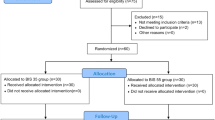Abstract
Objective
To test propofol lipid emulsion formulation for its immunosuppressive effects.
Design
Propofol lipid emulsion and the emulsion alone were tested at increasing concentrations and compared to initial values and between each other. Propofol alone could not be tested due to its insolubility into the culture medium.
Patients and participants
Lymphocytes from 12 surgical intensive care (ICU) patients (median APACHE score 16 and median TISS score 28) and 12 healthy volunteers.
Measurements
Phytohaemagglutinin-, concanavalin A-and pokeweed mitogen-induced lymphocyte proliferative responses were measured in the presence of increasing concentrations of propofol lipid emulsion formulation or the lipid emulsion.
Results
Lymphocyte proliferative responses from ICU patients were in general on a lower level than in the volunteers. The propofol lipid emulsion formulation (Diprivan®) decreased pokeweed mitogen-induced proliferative responses of lymphocytes from ICU patients at propofol concentrations found in the circulation (1–10 μg/ml) and the lipid emulsion alone at 100 μg/ml triglyceride concentrations while the other mitogen-induced responses were not affected. No changes were observed in the mitogen-induced responses of lymphocytes from healthy volunteers.
Conclusions
Propofol emulsion formulation decreased in surgical intensive care patients pokeweed mitogen-induced lymphocytic responses in vitro at clinically found concentrations, indicating the need for further studies to test B-lymphocyte functions and T-B-lymphocyte co-operation during propofol lipid emulsion administration.
Similar content being viewed by others
References
Rajah A, Morgan M (1991) Non-barbiturate drugs for the induction and maintenance of anaesthesia. Baillieres Clin Anaesthesiol 5:425–452
Sear JW (1991) Intravenous anaesthesia in the 1990s: a view from Europe. Baillieres Clin Anaesthesiol 5:399–424
Albanese J, Martin C, Lacarelle B, Saux P, Durand A, Gouin F (1990) Pharmacokinetics of long-term propofol infusion used for sedation in ICU patients. Anesthesiology 73:214–217
Palmblad J (1991) Intravenous lipid emulsion and host defense —a critical review. Clin Nutr 10:303–308
Böyum A (1968) Isolation of mononuclear cells and granulocytes from human blood. Scand J Clin Lab Invest 21[Suppl 97]:77–89
Eskola J, Soppi E, Viljanen M, Ruuskanen O (1975) A new micromethod for lymphocyte stimulation using whole blood. Immunol Commun 4:297–307
O'Mahony JB, Palder SB, Wood JJ, McIrvine A, Rodrick ML, Demling RH, Mannick JA (1984) Depression of cellular immunity after multiple trauma in the absence of sepsis. J Trauma 24:869–874
Salo M (1990) Inhibition of immunoglobulin synthesis in vitro by intravenous lipid emulsion (Intralipid). JPEN 14:459–462
Skeie B, Askanazi J, Rothkopf M, Rosenbaum SH, Kvetan V, Thomashow B (1988) Intravenous fat emulsions and lung function: a review. Crit Care Med 16:183–194
Lyte M, Shinitzky M (1985) A special lipid mixture for membrane fluidization. Biochim Biophys Acta 812:133–138
Sedman PC, Somers SS, Ramsden CW, Brennan TG, Guillou PJ (1991) Effects of different lipid emulsions on lymphocyte function during total parenteral nutrition. Br J Surg 78:1396–1399
Ladisch S, Poplack DG, Blaese MR (1982) Inhibition of human lymphoproliferation by intravenous lipid emulsion. Clin Immunol Immunopathol 25:196–202
Schüttler J, Kloos S, Schwilden H, Stoeckel H (1988) Total intravenous anaesthesia with propofol and alfentanil by computer-assisted infusion. Anaesthesia 43[Suppl]:2–7
Roberts FL, Dixon J, Lewis GTR, Tackley RM, Prys-Roberts C (1988) Induction and maintenance of propofol anaesthesia. A manual infusion scheme. Anaesthesia 43[Suppl]:14–17
Valtonen M, Kanto J, Rosenberg P (1989) Comparison of propofol and thiopentone for induction of anaesthesia for elective caesarean section. Anaesthesia 44:758–762
Kay NH, Sear JW, Uppington J, Cockshott ID, Douglas EJ (1986) Disposition of propofol in patients undergoing surgery. Br J Anaesth 58:1075–1079
Kelly JP, Parker CW (1979) Effects of arachidonic acid and other unsaturated fatty acids on mitogenesis in human lymphocytes. J Immunol 122:1556–1562
Author information
Authors and Affiliations
Rights and permissions
About this article
Cite this article
Pirttikangas, C.O., Perttilä, J. & Salo, M. Propofol emulsion reduces proliferative responses of lymphocytes from intensive care patients. Intensive Care Med 19, 299–302 (1993). https://doi.org/10.1007/BF01690552
Received:
Accepted:
Published:
Issue Date:
DOI: https://doi.org/10.1007/BF01690552




